Business Communication: Principles, Practices, and Analysis Report
VerifiedAdded on 2021/02/20
|10
|3043
|36
Report
AI Summary
This report provides a comprehensive overview of business communication within organizations. It delves into the principles and purposes behind various communication methods, including verbal and written forms, highlighting their significance in fostering clear and effective interactions. The report explores principles of effective communication such as clarity, simplicity, and brevity, emphasizing their role in enhancing communication practices. It analyzes communication practices specific to a case study involving "Mr. Fishy", examining how employees can improve communication across different cultural backgrounds by embracing active listening and adapting communication styles. The report discusses the analysis of communication challenges and barriers and concludes by emphasizing the importance of adhering to communication principles for promoting better understanding and relationships within an organization. The report offers a valuable resource for students seeking to understand the dynamics of effective business communication.

Business Communication
Paraphrase This Document
Need a fresh take? Get an instant paraphrase of this document with our AI Paraphraser
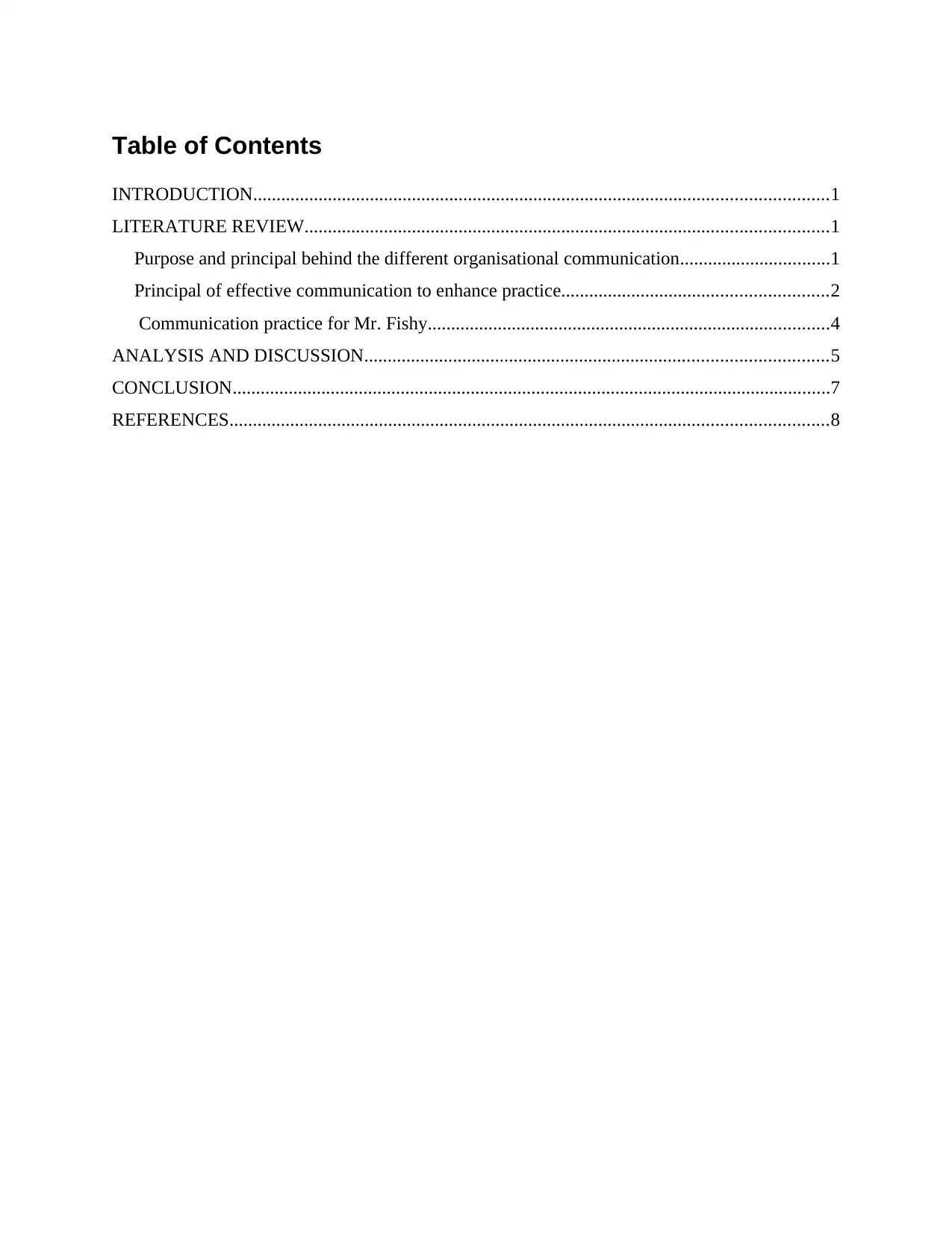
Table of Contents
INTRODUCTION...........................................................................................................................1
LITERATURE REVIEW................................................................................................................1
Purpose and principal behind the different organisational communication................................1
Principal of effective communication to enhance practice.........................................................2
Communication practice for Mr. Fishy......................................................................................4
ANALYSIS AND DISCUSSION...................................................................................................5
CONCLUSION................................................................................................................................7
REFERENCES................................................................................................................................8
INTRODUCTION...........................................................................................................................1
LITERATURE REVIEW................................................................................................................1
Purpose and principal behind the different organisational communication................................1
Principal of effective communication to enhance practice.........................................................2
Communication practice for Mr. Fishy......................................................................................4
ANALYSIS AND DISCUSSION...................................................................................................5
CONCLUSION................................................................................................................................7
REFERENCES................................................................................................................................8
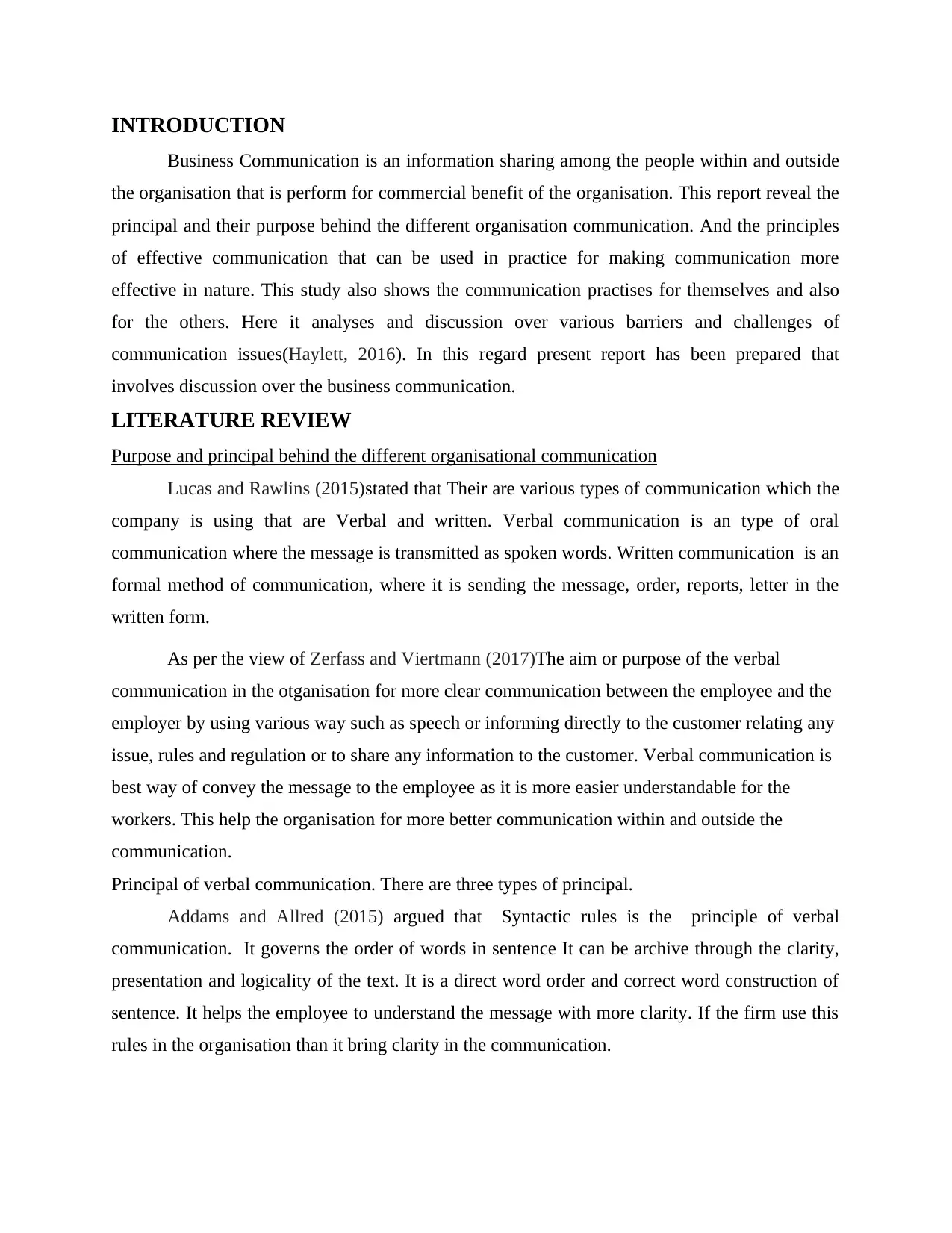
INTRODUCTION
Business Communication is an information sharing among the people within and outside
the organisation that is perform for commercial benefit of the organisation. This report reveal the
principal and their purpose behind the different organisation communication. And the principles
of effective communication that can be used in practice for making communication more
effective in nature. This study also shows the communication practises for themselves and also
for the others. Here it analyses and discussion over various barriers and challenges of
communication issues(Haylett, 2016). In this regard present report has been prepared that
involves discussion over the business communication.
LITERATURE REVIEW
Purpose and principal behind the different organisational communication
Lucas and Rawlins (2015)stated that Their are various types of communication which the
company is using that are Verbal and written. Verbal communication is an type of oral
communication where the message is transmitted as spoken words. Written communication is an
formal method of communication, where it is sending the message, order, reports, letter in the
written form.
As per the view of Zerfass and Viertmann (2017)The aim or purpose of the verbal
communication in the otganisation for more clear communication between the employee and the
employer by using various way such as speech or informing directly to the customer relating any
issue, rules and regulation or to share any information to the customer. Verbal communication is
best way of convey the message to the employee as it is more easier understandable for the
workers. This help the organisation for more better communication within and outside the
communication.
Principal of verbal communication. There are three types of principal.
Addams and Allred (2015) argued that Syntactic rules is the principle of verbal
communication. It governs the order of words in sentence It can be archive through the clarity,
presentation and logicality of the text. It is a direct word order and correct word construction of
sentence. It helps the employee to understand the message with more clarity. If the firm use this
rules in the organisation than it bring clarity in the communication.
Business Communication is an information sharing among the people within and outside
the organisation that is perform for commercial benefit of the organisation. This report reveal the
principal and their purpose behind the different organisation communication. And the principles
of effective communication that can be used in practice for making communication more
effective in nature. This study also shows the communication practises for themselves and also
for the others. Here it analyses and discussion over various barriers and challenges of
communication issues(Haylett, 2016). In this regard present report has been prepared that
involves discussion over the business communication.
LITERATURE REVIEW
Purpose and principal behind the different organisational communication
Lucas and Rawlins (2015)stated that Their are various types of communication which the
company is using that are Verbal and written. Verbal communication is an type of oral
communication where the message is transmitted as spoken words. Written communication is an
formal method of communication, where it is sending the message, order, reports, letter in the
written form.
As per the view of Zerfass and Viertmann (2017)The aim or purpose of the verbal
communication in the otganisation for more clear communication between the employee and the
employer by using various way such as speech or informing directly to the customer relating any
issue, rules and regulation or to share any information to the customer. Verbal communication is
best way of convey the message to the employee as it is more easier understandable for the
workers. This help the organisation for more better communication within and outside the
communication.
Principal of verbal communication. There are three types of principal.
Addams and Allred (2015) argued that Syntactic rules is the principle of verbal
communication. It governs the order of words in sentence It can be archive through the clarity,
presentation and logicality of the text. It is a direct word order and correct word construction of
sentence. It helps the employee to understand the message with more clarity. If the firm use this
rules in the organisation than it bring clarity in the communication.
⊘ This is a preview!⊘
Do you want full access?
Subscribe today to unlock all pages.

Trusted by 1+ million students worldwide
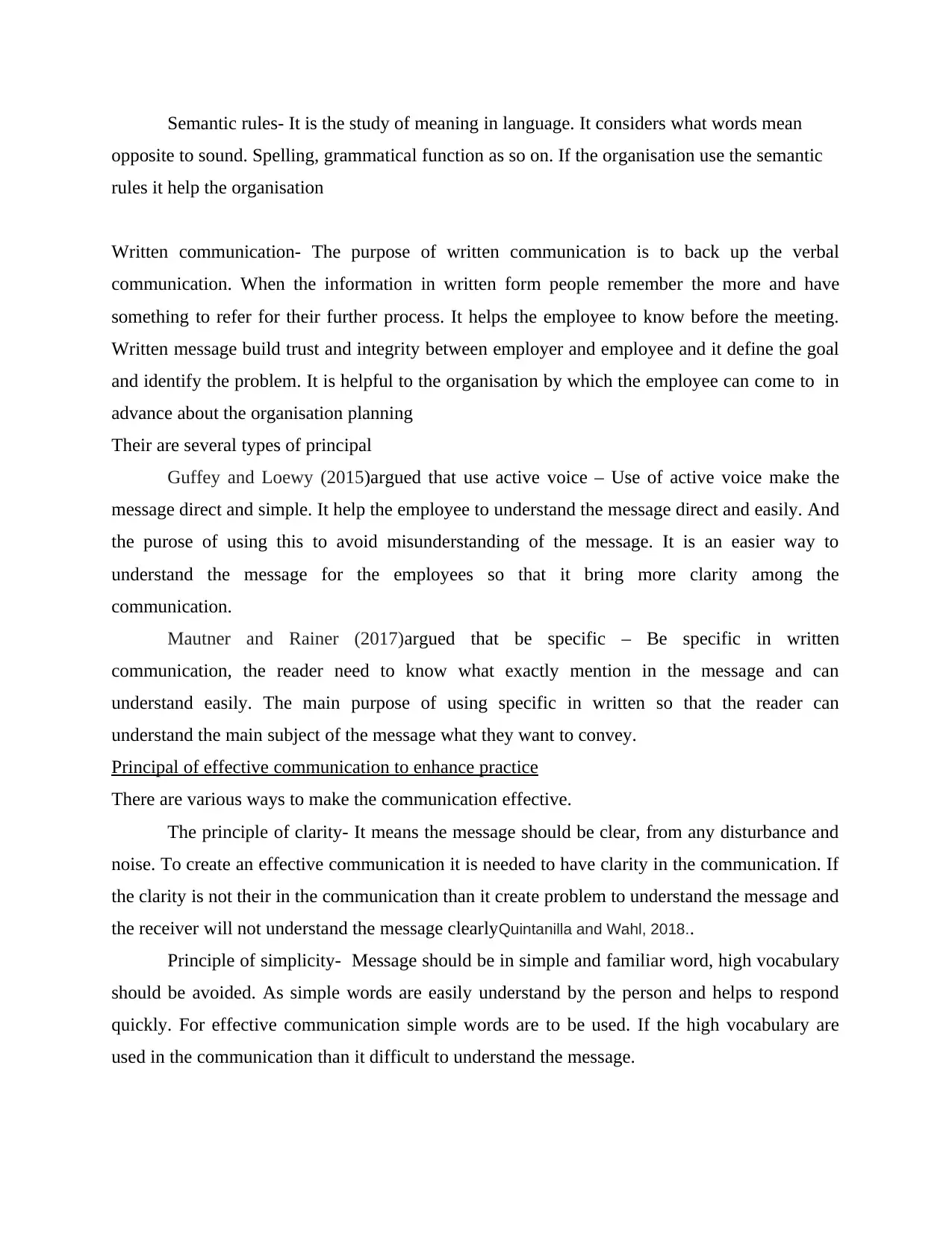
Semantic rules- It is the study of meaning in language. It considers what words mean
opposite to sound. Spelling, grammatical function as so on. If the organisation use the semantic
rules it help the organisation
Written communication- The purpose of written communication is to back up the verbal
communication. When the information in written form people remember the more and have
something to refer for their further process. It helps the employee to know before the meeting.
Written message build trust and integrity between employer and employee and it define the goal
and identify the problem. It is helpful to the organisation by which the employee can come to in
advance about the organisation planning
Their are several types of principal
Guffey and Loewy (2015)argued that use active voice – Use of active voice make the
message direct and simple. It help the employee to understand the message direct and easily. And
the purose of using this to avoid misunderstanding of the message. It is an easier way to
understand the message for the employees so that it bring more clarity among the
communication.
Mautner and Rainer (2017)argued that be specific – Be specific in written
communication, the reader need to know what exactly mention in the message and can
understand easily. The main purpose of using specific in written so that the reader can
understand the main subject of the message what they want to convey.
Principal of effective communication to enhance practice
There are various ways to make the communication effective.
The principle of clarity- It means the message should be clear, from any disturbance and
noise. To create an effective communication it is needed to have clarity in the communication. If
the clarity is not their in the communication than it create problem to understand the message and
the receiver will not understand the message clearlyQuintanilla and Wahl, 2018..
Principle of simplicity- Message should be in simple and familiar word, high vocabulary
should be avoided. As simple words are easily understand by the person and helps to respond
quickly. For effective communication simple words are to be used. If the high vocabulary are
used in the communication than it difficult to understand the message.
opposite to sound. Spelling, grammatical function as so on. If the organisation use the semantic
rules it help the organisation
Written communication- The purpose of written communication is to back up the verbal
communication. When the information in written form people remember the more and have
something to refer for their further process. It helps the employee to know before the meeting.
Written message build trust and integrity between employer and employee and it define the goal
and identify the problem. It is helpful to the organisation by which the employee can come to in
advance about the organisation planning
Their are several types of principal
Guffey and Loewy (2015)argued that use active voice – Use of active voice make the
message direct and simple. It help the employee to understand the message direct and easily. And
the purose of using this to avoid misunderstanding of the message. It is an easier way to
understand the message for the employees so that it bring more clarity among the
communication.
Mautner and Rainer (2017)argued that be specific – Be specific in written
communication, the reader need to know what exactly mention in the message and can
understand easily. The main purpose of using specific in written so that the reader can
understand the main subject of the message what they want to convey.
Principal of effective communication to enhance practice
There are various ways to make the communication effective.
The principle of clarity- It means the message should be clear, from any disturbance and
noise. To create an effective communication it is needed to have clarity in the communication. If
the clarity is not their in the communication than it create problem to understand the message and
the receiver will not understand the message clearlyQuintanilla and Wahl, 2018..
Principle of simplicity- Message should be in simple and familiar word, high vocabulary
should be avoided. As simple words are easily understand by the person and helps to respond
quickly. For effective communication simple words are to be used. If the high vocabulary are
used in the communication than it difficult to understand the message.
Paraphrase This Document
Need a fresh take? Get an instant paraphrase of this document with our AI Paraphraser
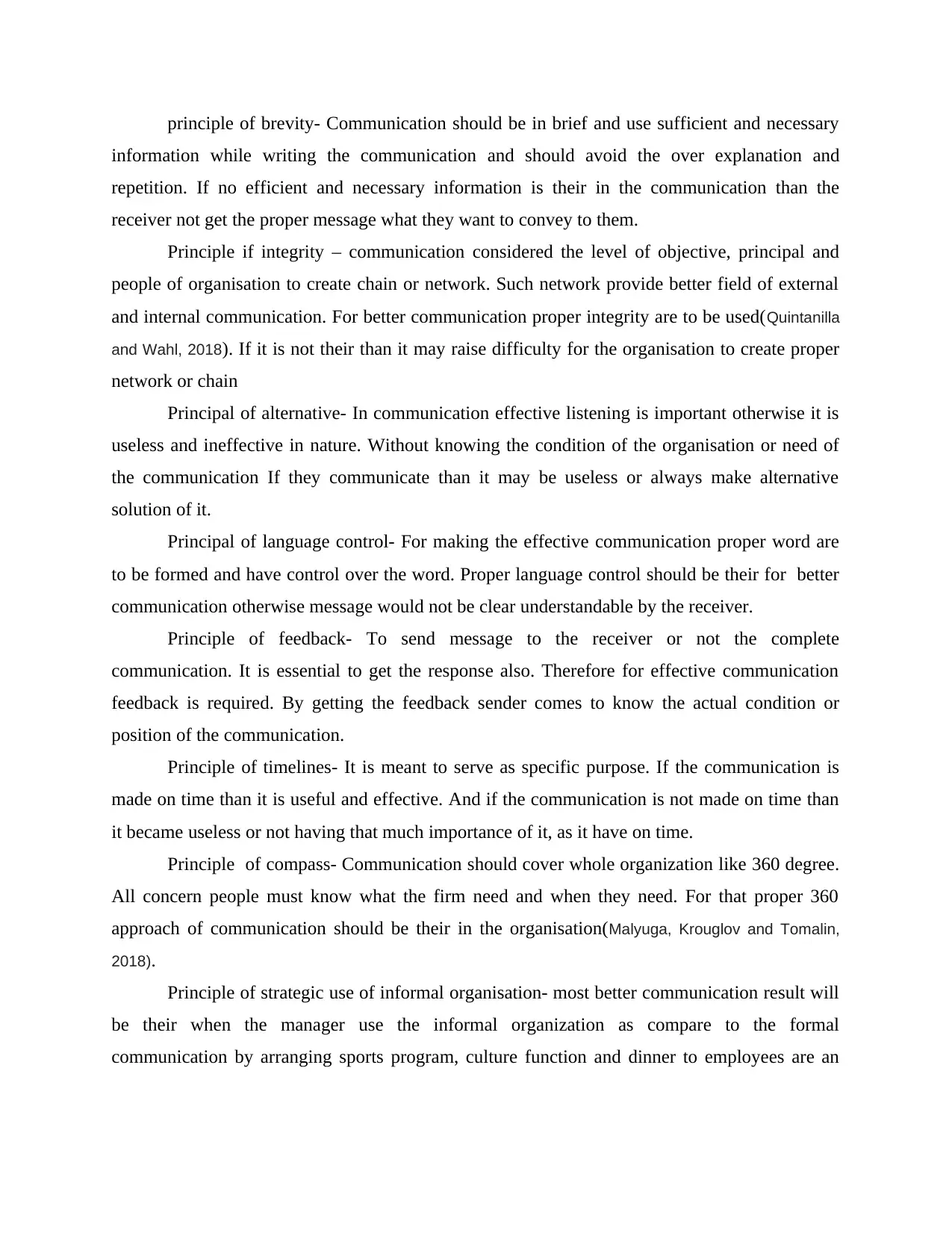
principle of brevity- Communication should be in brief and use sufficient and necessary
information while writing the communication and should avoid the over explanation and
repetition. If no efficient and necessary information is their in the communication than the
receiver not get the proper message what they want to convey to them.
Principle if integrity – communication considered the level of objective, principal and
people of organisation to create chain or network. Such network provide better field of external
and internal communication. For better communication proper integrity are to be used(Quintanilla
and Wahl, 2018). If it is not their than it may raise difficulty for the organisation to create proper
network or chain
Principal of alternative- In communication effective listening is important otherwise it is
useless and ineffective in nature. Without knowing the condition of the organisation or need of
the communication If they communicate than it may be useless or always make alternative
solution of it.
Principal of language control- For making the effective communication proper word are
to be formed and have control over the word. Proper language control should be their for better
communication otherwise message would not be clear understandable by the receiver.
Principle of feedback- To send message to the receiver or not the complete
communication. It is essential to get the response also. Therefore for effective communication
feedback is required. By getting the feedback sender comes to know the actual condition or
position of the communication.
Principle of timelines- It is meant to serve as specific purpose. If the communication is
made on time than it is useful and effective. And if the communication is not made on time than
it became useless or not having that much importance of it, as it have on time.
Principle of compass- Communication should cover whole organization like 360 degree.
All concern people must know what the firm need and when they need. For that proper 360
approach of communication should be their in the organisation(Malyuga, Krouglov and Tomalin,
2018).
Principle of strategic use of informal organisation- most better communication result will
be their when the manager use the informal organization as compare to the formal
communication by arranging sports program, culture function and dinner to employees are an
information while writing the communication and should avoid the over explanation and
repetition. If no efficient and necessary information is their in the communication than the
receiver not get the proper message what they want to convey to them.
Principle if integrity – communication considered the level of objective, principal and
people of organisation to create chain or network. Such network provide better field of external
and internal communication. For better communication proper integrity are to be used(Quintanilla
and Wahl, 2018). If it is not their than it may raise difficulty for the organisation to create proper
network or chain
Principal of alternative- In communication effective listening is important otherwise it is
useless and ineffective in nature. Without knowing the condition of the organisation or need of
the communication If they communicate than it may be useless or always make alternative
solution of it.
Principal of language control- For making the effective communication proper word are
to be formed and have control over the word. Proper language control should be their for better
communication otherwise message would not be clear understandable by the receiver.
Principle of feedback- To send message to the receiver or not the complete
communication. It is essential to get the response also. Therefore for effective communication
feedback is required. By getting the feedback sender comes to know the actual condition or
position of the communication.
Principle of timelines- It is meant to serve as specific purpose. If the communication is
made on time than it is useful and effective. And if the communication is not made on time than
it became useless or not having that much importance of it, as it have on time.
Principle of compass- Communication should cover whole organization like 360 degree.
All concern people must know what the firm need and when they need. For that proper 360
approach of communication should be their in the organisation(Malyuga, Krouglov and Tomalin,
2018).
Principle of strategic use of informal organisation- most better communication result will
be their when the manager use the informal organization as compare to the formal
communication by arranging sports program, culture function and dinner to employees are an
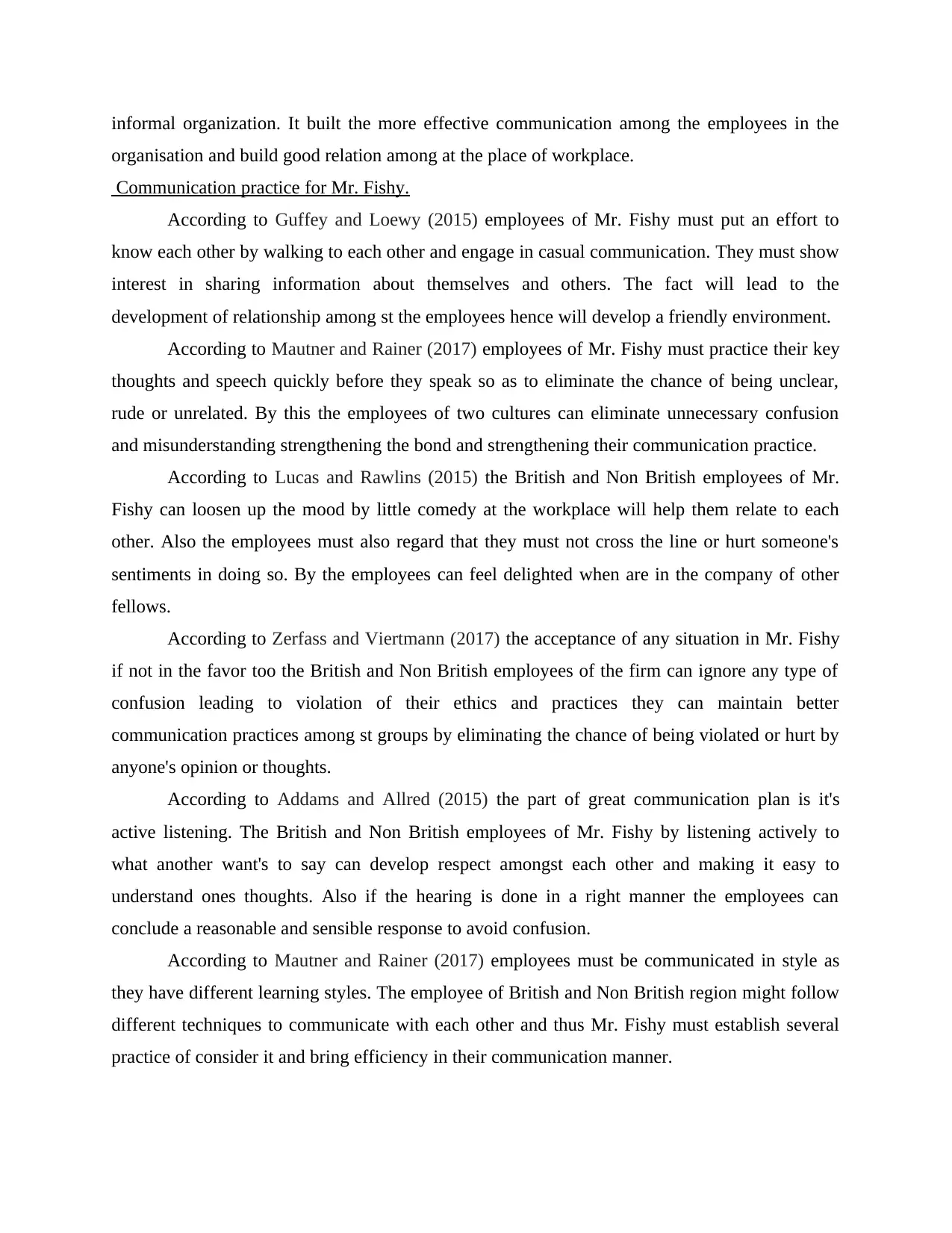
informal organization. It built the more effective communication among the employees in the
organisation and build good relation among at the place of workplace.
Communication practice for Mr. Fishy.
According to Guffey and Loewy (2015) employees of Mr. Fishy must put an effort to
know each other by walking to each other and engage in casual communication. They must show
interest in sharing information about themselves and others. The fact will lead to the
development of relationship among st the employees hence will develop a friendly environment.
According to Mautner and Rainer (2017) employees of Mr. Fishy must practice their key
thoughts and speech quickly before they speak so as to eliminate the chance of being unclear,
rude or unrelated. By this the employees of two cultures can eliminate unnecessary confusion
and misunderstanding strengthening the bond and strengthening their communication practice.
According to Lucas and Rawlins (2015) the British and Non British employees of Mr.
Fishy can loosen up the mood by little comedy at the workplace will help them relate to each
other. Also the employees must also regard that they must not cross the line or hurt someone's
sentiments in doing so. By the employees can feel delighted when are in the company of other
fellows.
According to Zerfass and Viertmann (2017) the acceptance of any situation in Mr. Fishy
if not in the favor too the British and Non British employees of the firm can ignore any type of
confusion leading to violation of their ethics and practices they can maintain better
communication practices among st groups by eliminating the chance of being violated or hurt by
anyone's opinion or thoughts.
According to Addams and Allred (2015) the part of great communication plan is it's
active listening. The British and Non British employees of Mr. Fishy by listening actively to
what another want's to say can develop respect amongst each other and making it easy to
understand ones thoughts. Also if the hearing is done in a right manner the employees can
conclude a reasonable and sensible response to avoid confusion.
According to Mautner and Rainer (2017) employees must be communicated in style as
they have different learning styles. The employee of British and Non British region might follow
different techniques to communicate with each other and thus Mr. Fishy must establish several
practice of consider it and bring efficiency in their communication manner.
organisation and build good relation among at the place of workplace.
Communication practice for Mr. Fishy.
According to Guffey and Loewy (2015) employees of Mr. Fishy must put an effort to
know each other by walking to each other and engage in casual communication. They must show
interest in sharing information about themselves and others. The fact will lead to the
development of relationship among st the employees hence will develop a friendly environment.
According to Mautner and Rainer (2017) employees of Mr. Fishy must practice their key
thoughts and speech quickly before they speak so as to eliminate the chance of being unclear,
rude or unrelated. By this the employees of two cultures can eliminate unnecessary confusion
and misunderstanding strengthening the bond and strengthening their communication practice.
According to Lucas and Rawlins (2015) the British and Non British employees of Mr.
Fishy can loosen up the mood by little comedy at the workplace will help them relate to each
other. Also the employees must also regard that they must not cross the line or hurt someone's
sentiments in doing so. By the employees can feel delighted when are in the company of other
fellows.
According to Zerfass and Viertmann (2017) the acceptance of any situation in Mr. Fishy
if not in the favor too the British and Non British employees of the firm can ignore any type of
confusion leading to violation of their ethics and practices they can maintain better
communication practices among st groups by eliminating the chance of being violated or hurt by
anyone's opinion or thoughts.
According to Addams and Allred (2015) the part of great communication plan is it's
active listening. The British and Non British employees of Mr. Fishy by listening actively to
what another want's to say can develop respect amongst each other and making it easy to
understand ones thoughts. Also if the hearing is done in a right manner the employees can
conclude a reasonable and sensible response to avoid confusion.
According to Mautner and Rainer (2017) employees must be communicated in style as
they have different learning styles. The employee of British and Non British region might follow
different techniques to communicate with each other and thus Mr. Fishy must establish several
practice of consider it and bring efficiency in their communication manner.
⊘ This is a preview!⊘
Do you want full access?
Subscribe today to unlock all pages.

Trusted by 1+ million students worldwide
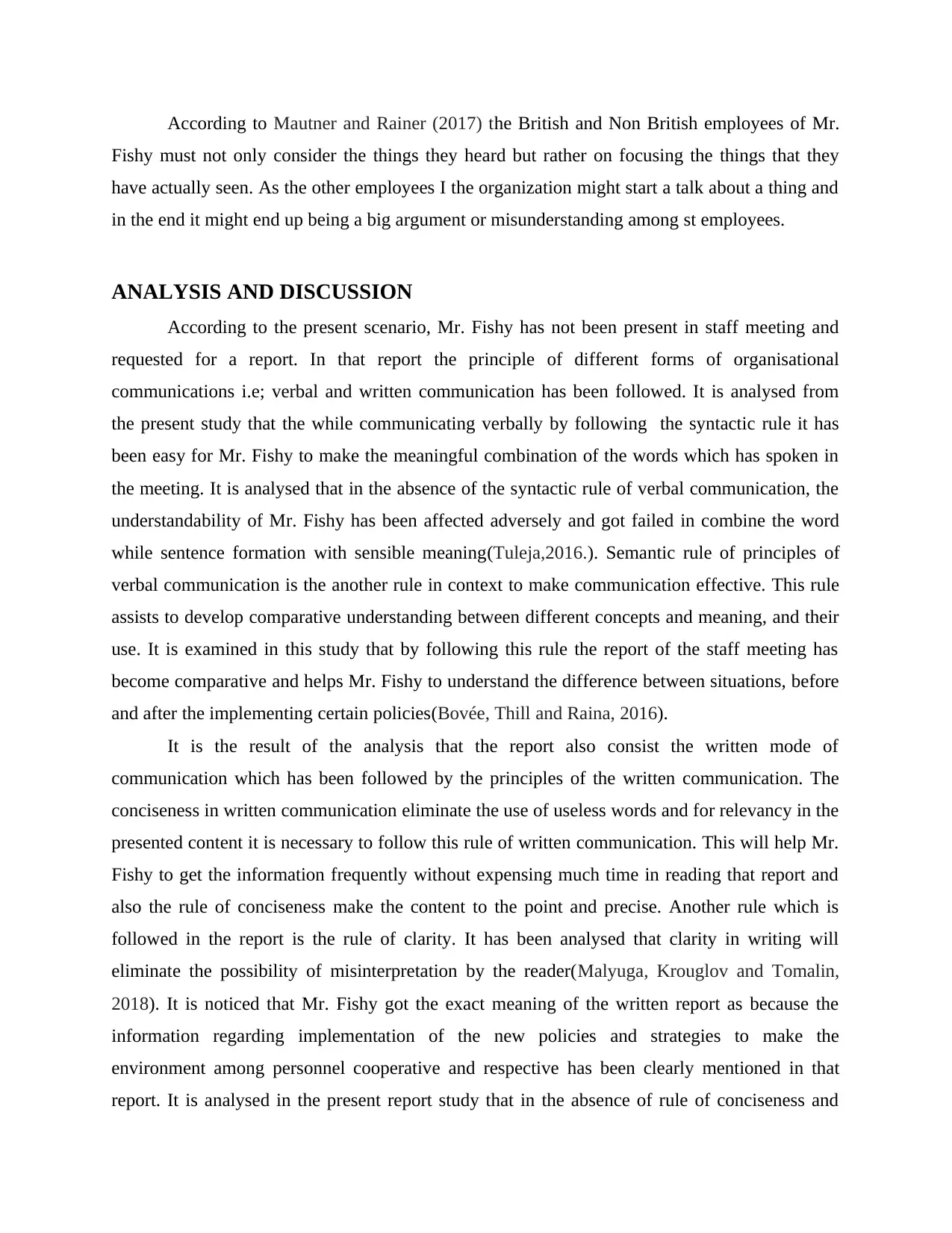
According to Mautner and Rainer (2017) the British and Non British employees of Mr.
Fishy must not only consider the things they heard but rather on focusing the things that they
have actually seen. As the other employees I the organization might start a talk about a thing and
in the end it might end up being a big argument or misunderstanding among st employees.
ANALYSIS AND DISCUSSION
According to the present scenario, Mr. Fishy has not been present in staff meeting and
requested for a report. In that report the principle of different forms of organisational
communications i.e; verbal and written communication has been followed. It is analysed from
the present study that the while communicating verbally by following the syntactic rule it has
been easy for Mr. Fishy to make the meaningful combination of the words which has spoken in
the meeting. It is analysed that in the absence of the syntactic rule of verbal communication, the
understandability of Mr. Fishy has been affected adversely and got failed in combine the word
while sentence formation with sensible meaning(Tuleja,2016.). Semantic rule of principles of
verbal communication is the another rule in context to make communication effective. This rule
assists to develop comparative understanding between different concepts and meaning, and their
use. It is examined in this study that by following this rule the report of the staff meeting has
become comparative and helps Mr. Fishy to understand the difference between situations, before
and after the implementing certain policies(Bovée, Thill and Raina, 2016).
It is the result of the analysis that the report also consist the written mode of
communication which has been followed by the principles of the written communication. The
conciseness in written communication eliminate the use of useless words and for relevancy in the
presented content it is necessary to follow this rule of written communication. This will help Mr.
Fishy to get the information frequently without expensing much time in reading that report and
also the rule of conciseness make the content to the point and precise. Another rule which is
followed in the report is the rule of clarity. It has been analysed that clarity in writing will
eliminate the possibility of misinterpretation by the reader(Malyuga, Krouglov and Tomalin,
2018). It is noticed that Mr. Fishy got the exact meaning of the written report as because the
information regarding implementation of the new policies and strategies to make the
environment among personnel cooperative and respective has been clearly mentioned in that
report. It is analysed in the present report study that in the absence of rule of conciseness and
Fishy must not only consider the things they heard but rather on focusing the things that they
have actually seen. As the other employees I the organization might start a talk about a thing and
in the end it might end up being a big argument or misunderstanding among st employees.
ANALYSIS AND DISCUSSION
According to the present scenario, Mr. Fishy has not been present in staff meeting and
requested for a report. In that report the principle of different forms of organisational
communications i.e; verbal and written communication has been followed. It is analysed from
the present study that the while communicating verbally by following the syntactic rule it has
been easy for Mr. Fishy to make the meaningful combination of the words which has spoken in
the meeting. It is analysed that in the absence of the syntactic rule of verbal communication, the
understandability of Mr. Fishy has been affected adversely and got failed in combine the word
while sentence formation with sensible meaning(Tuleja,2016.). Semantic rule of principles of
verbal communication is the another rule in context to make communication effective. This rule
assists to develop comparative understanding between different concepts and meaning, and their
use. It is examined in this study that by following this rule the report of the staff meeting has
become comparative and helps Mr. Fishy to understand the difference between situations, before
and after the implementing certain policies(Bovée, Thill and Raina, 2016).
It is the result of the analysis that the report also consist the written mode of
communication which has been followed by the principles of the written communication. The
conciseness in written communication eliminate the use of useless words and for relevancy in the
presented content it is necessary to follow this rule of written communication. This will help Mr.
Fishy to get the information frequently without expensing much time in reading that report and
also the rule of conciseness make the content to the point and precise. Another rule which is
followed in the report is the rule of clarity. It has been analysed that clarity in writing will
eliminate the possibility of misinterpretation by the reader(Malyuga, Krouglov and Tomalin,
2018). It is noticed that Mr. Fishy got the exact meaning of the written report as because the
information regarding implementation of the new policies and strategies to make the
environment among personnel cooperative and respective has been clearly mentioned in that
report. It is analysed in the present report study that in the absence of rule of conciseness and
Paraphrase This Document
Need a fresh take? Get an instant paraphrase of this document with our AI Paraphraser
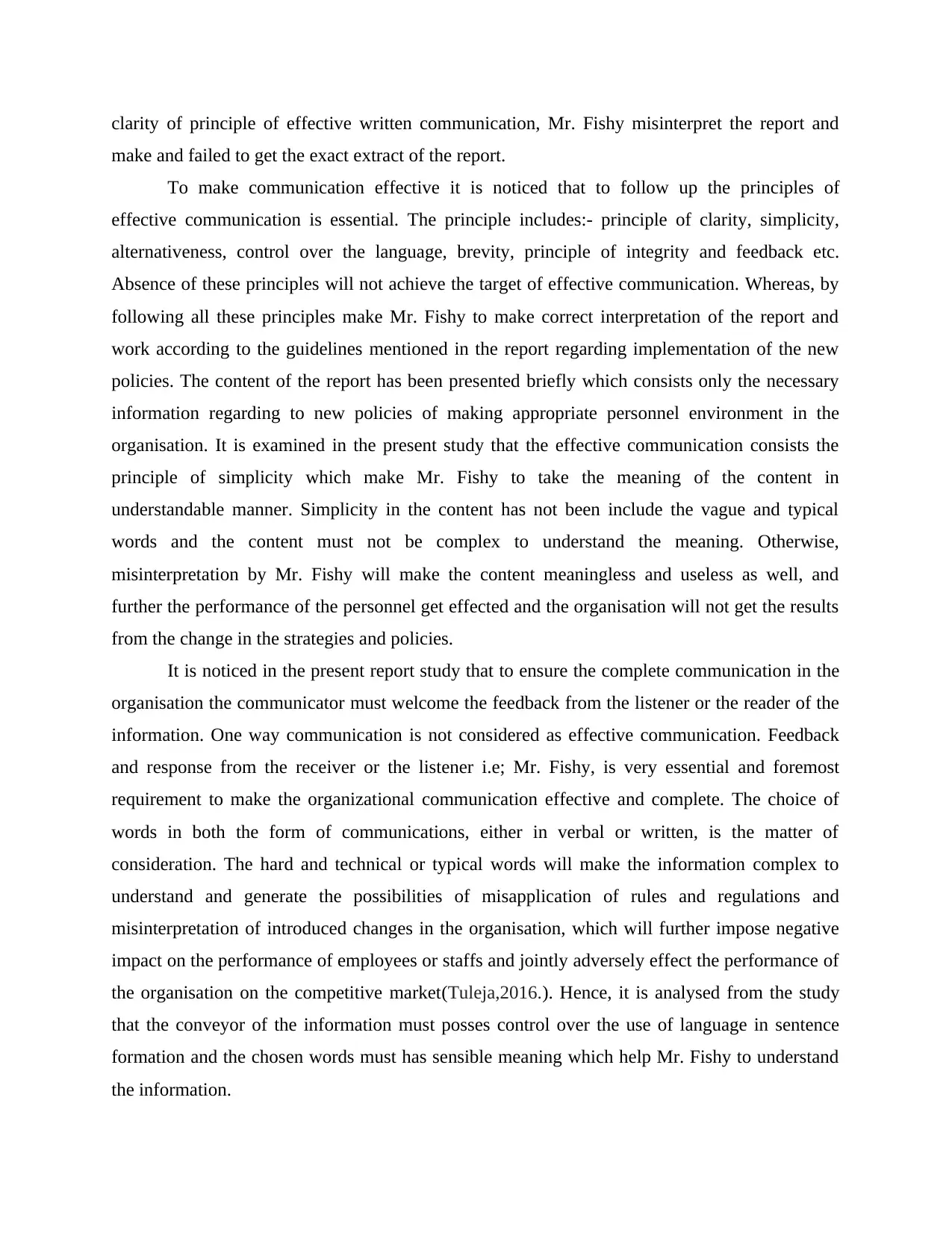
clarity of principle of effective written communication, Mr. Fishy misinterpret the report and
make and failed to get the exact extract of the report.
To make communication effective it is noticed that to follow up the principles of
effective communication is essential. The principle includes:- principle of clarity, simplicity,
alternativeness, control over the language, brevity, principle of integrity and feedback etc.
Absence of these principles will not achieve the target of effective communication. Whereas, by
following all these principles make Mr. Fishy to make correct interpretation of the report and
work according to the guidelines mentioned in the report regarding implementation of the new
policies. The content of the report has been presented briefly which consists only the necessary
information regarding to new policies of making appropriate personnel environment in the
organisation. It is examined in the present study that the effective communication consists the
principle of simplicity which make Mr. Fishy to take the meaning of the content in
understandable manner. Simplicity in the content has not been include the vague and typical
words and the content must not be complex to understand the meaning. Otherwise,
misinterpretation by Mr. Fishy will make the content meaningless and useless as well, and
further the performance of the personnel get effected and the organisation will not get the results
from the change in the strategies and policies.
It is noticed in the present report study that to ensure the complete communication in the
organisation the communicator must welcome the feedback from the listener or the reader of the
information. One way communication is not considered as effective communication. Feedback
and response from the receiver or the listener i.e; Mr. Fishy, is very essential and foremost
requirement to make the organizational communication effective and complete. The choice of
words in both the form of communications, either in verbal or written, is the matter of
consideration. The hard and technical or typical words will make the information complex to
understand and generate the possibilities of misapplication of rules and regulations and
misinterpretation of introduced changes in the organisation, which will further impose negative
impact on the performance of employees or staffs and jointly adversely effect the performance of
the organisation on the competitive market(Tuleja,2016.). Hence, it is analysed from the study
that the conveyor of the information must posses control over the use of language in sentence
formation and the chosen words must has sensible meaning which help Mr. Fishy to understand
the information.
make and failed to get the exact extract of the report.
To make communication effective it is noticed that to follow up the principles of
effective communication is essential. The principle includes:- principle of clarity, simplicity,
alternativeness, control over the language, brevity, principle of integrity and feedback etc.
Absence of these principles will not achieve the target of effective communication. Whereas, by
following all these principles make Mr. Fishy to make correct interpretation of the report and
work according to the guidelines mentioned in the report regarding implementation of the new
policies. The content of the report has been presented briefly which consists only the necessary
information regarding to new policies of making appropriate personnel environment in the
organisation. It is examined in the present study that the effective communication consists the
principle of simplicity which make Mr. Fishy to take the meaning of the content in
understandable manner. Simplicity in the content has not been include the vague and typical
words and the content must not be complex to understand the meaning. Otherwise,
misinterpretation by Mr. Fishy will make the content meaningless and useless as well, and
further the performance of the personnel get effected and the organisation will not get the results
from the change in the strategies and policies.
It is noticed in the present report study that to ensure the complete communication in the
organisation the communicator must welcome the feedback from the listener or the reader of the
information. One way communication is not considered as effective communication. Feedback
and response from the receiver or the listener i.e; Mr. Fishy, is very essential and foremost
requirement to make the organizational communication effective and complete. The choice of
words in both the form of communications, either in verbal or written, is the matter of
consideration. The hard and technical or typical words will make the information complex to
understand and generate the possibilities of misapplication of rules and regulations and
misinterpretation of introduced changes in the organisation, which will further impose negative
impact on the performance of employees or staffs and jointly adversely effect the performance of
the organisation on the competitive market(Tuleja,2016.). Hence, it is analysed from the study
that the conveyor of the information must posses control over the use of language in sentence
formation and the chosen words must has sensible meaning which help Mr. Fishy to understand
the information.

CONCLUSION
From the above study it can be concluded that verbal communication is more effective as
compare to the written communication as by using the verbal communication it can be more
understandable as compare to the written, whereas in written communication takes more time in
delivering the information but written comunication
From the above study it can be concluded that verbal communication is more effective as
compare to the written communication as by using the verbal communication it can be more
understandable as compare to the written, whereas in written communication takes more time in
delivering the information but written comunication
⊘ This is a preview!⊘
Do you want full access?
Subscribe today to unlock all pages.

Trusted by 1+ million students worldwide
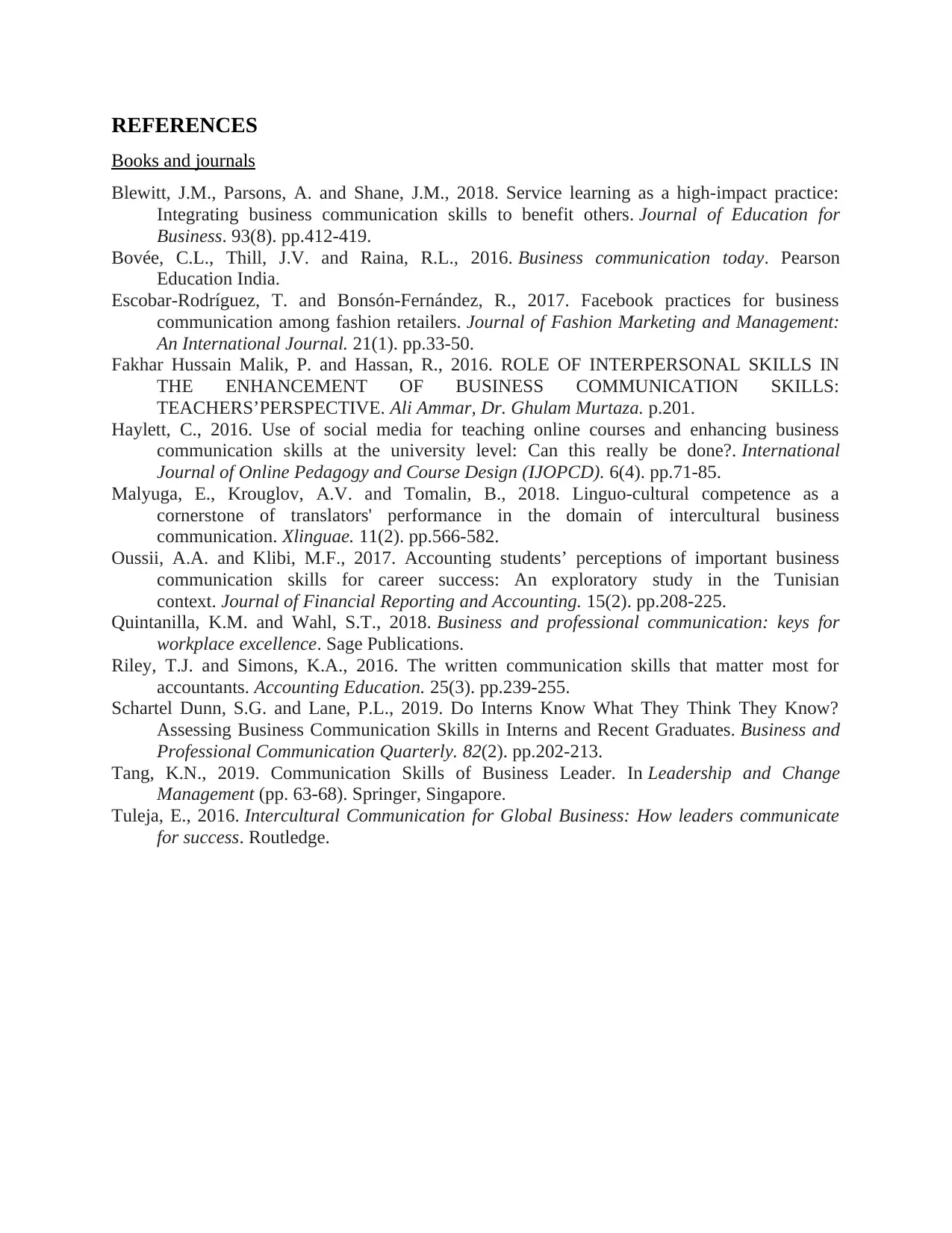
REFERENCES
Books and journals
Blewitt, J.M., Parsons, A. and Shane, J.M., 2018. Service learning as a high-impact practice:
Integrating business communication skills to benefit others. Journal of Education for
Business. 93(8). pp.412-419.
Bovée, C.L., Thill, J.V. and Raina, R.L., 2016. Business communication today. Pearson
Education India.
Escobar-Rodríguez, T. and Bonsón-Fernández, R., 2017. Facebook practices for business
communication among fashion retailers. Journal of Fashion Marketing and Management:
An International Journal. 21(1). pp.33-50.
Fakhar Hussain Malik, P. and Hassan, R., 2016. ROLE OF INTERPERSONAL SKILLS IN
THE ENHANCEMENT OF BUSINESS COMMUNICATION SKILLS:
TEACHERS’PERSPECTIVE. Ali Ammar, Dr. Ghulam Murtaza. p.201.
Haylett, C., 2016. Use of social media for teaching online courses and enhancing business
communication skills at the university level: Can this really be done?. International
Journal of Online Pedagogy and Course Design (IJOPCD). 6(4). pp.71-85.
Malyuga, E., Krouglov, A.V. and Tomalin, B., 2018. Linguo-cultural competence as a
cornerstone of translators' performance in the domain of intercultural business
communication. Xlinguae. 11(2). pp.566-582.
Oussii, A.A. and Klibi, M.F., 2017. Accounting students’ perceptions of important business
communication skills for career success: An exploratory study in the Tunisian
context. Journal of Financial Reporting and Accounting. 15(2). pp.208-225.
Quintanilla, K.M. and Wahl, S.T., 2018. Business and professional communication: keys for
workplace excellence. Sage Publications.
Riley, T.J. and Simons, K.A., 2016. The written communication skills that matter most for
accountants. Accounting Education. 25(3). pp.239-255.
Schartel Dunn, S.G. and Lane, P.L., 2019. Do Interns Know What They Think They Know?
Assessing Business Communication Skills in Interns and Recent Graduates. Business and
Professional Communication Quarterly. 82(2). pp.202-213.
Tang, K.N., 2019. Communication Skills of Business Leader. In Leadership and Change
Management (pp. 63-68). Springer, Singapore.
Tuleja, E., 2016. Intercultural Communication for Global Business: How leaders communicate
for success. Routledge.
Books and journals
Blewitt, J.M., Parsons, A. and Shane, J.M., 2018. Service learning as a high-impact practice:
Integrating business communication skills to benefit others. Journal of Education for
Business. 93(8). pp.412-419.
Bovée, C.L., Thill, J.V. and Raina, R.L., 2016. Business communication today. Pearson
Education India.
Escobar-Rodríguez, T. and Bonsón-Fernández, R., 2017. Facebook practices for business
communication among fashion retailers. Journal of Fashion Marketing and Management:
An International Journal. 21(1). pp.33-50.
Fakhar Hussain Malik, P. and Hassan, R., 2016. ROLE OF INTERPERSONAL SKILLS IN
THE ENHANCEMENT OF BUSINESS COMMUNICATION SKILLS:
TEACHERS’PERSPECTIVE. Ali Ammar, Dr. Ghulam Murtaza. p.201.
Haylett, C., 2016. Use of social media for teaching online courses and enhancing business
communication skills at the university level: Can this really be done?. International
Journal of Online Pedagogy and Course Design (IJOPCD). 6(4). pp.71-85.
Malyuga, E., Krouglov, A.V. and Tomalin, B., 2018. Linguo-cultural competence as a
cornerstone of translators' performance in the domain of intercultural business
communication. Xlinguae. 11(2). pp.566-582.
Oussii, A.A. and Klibi, M.F., 2017. Accounting students’ perceptions of important business
communication skills for career success: An exploratory study in the Tunisian
context. Journal of Financial Reporting and Accounting. 15(2). pp.208-225.
Quintanilla, K.M. and Wahl, S.T., 2018. Business and professional communication: keys for
workplace excellence. Sage Publications.
Riley, T.J. and Simons, K.A., 2016. The written communication skills that matter most for
accountants. Accounting Education. 25(3). pp.239-255.
Schartel Dunn, S.G. and Lane, P.L., 2019. Do Interns Know What They Think They Know?
Assessing Business Communication Skills in Interns and Recent Graduates. Business and
Professional Communication Quarterly. 82(2). pp.202-213.
Tang, K.N., 2019. Communication Skills of Business Leader. In Leadership and Change
Management (pp. 63-68). Springer, Singapore.
Tuleja, E., 2016. Intercultural Communication for Global Business: How leaders communicate
for success. Routledge.
1 out of 10
Related Documents
Your All-in-One AI-Powered Toolkit for Academic Success.
+13062052269
info@desklib.com
Available 24*7 on WhatsApp / Email
![[object Object]](/_next/static/media/star-bottom.7253800d.svg)
Unlock your academic potential
Copyright © 2020–2025 A2Z Services. All Rights Reserved. Developed and managed by ZUCOL.





